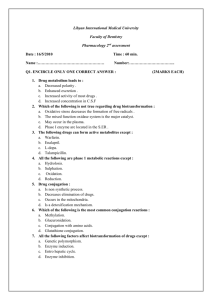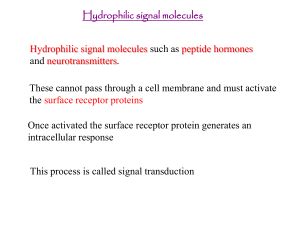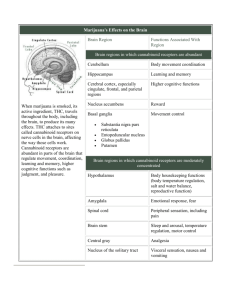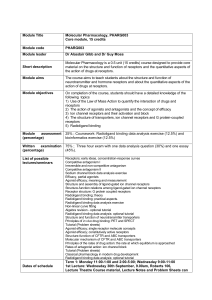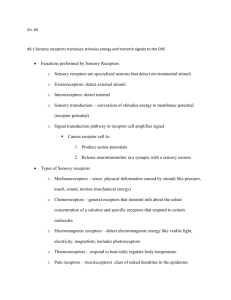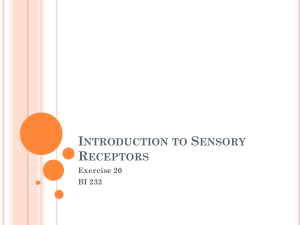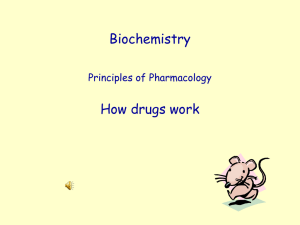Pharmacology LOs wk 7 - PBL-J-2015
advertisement
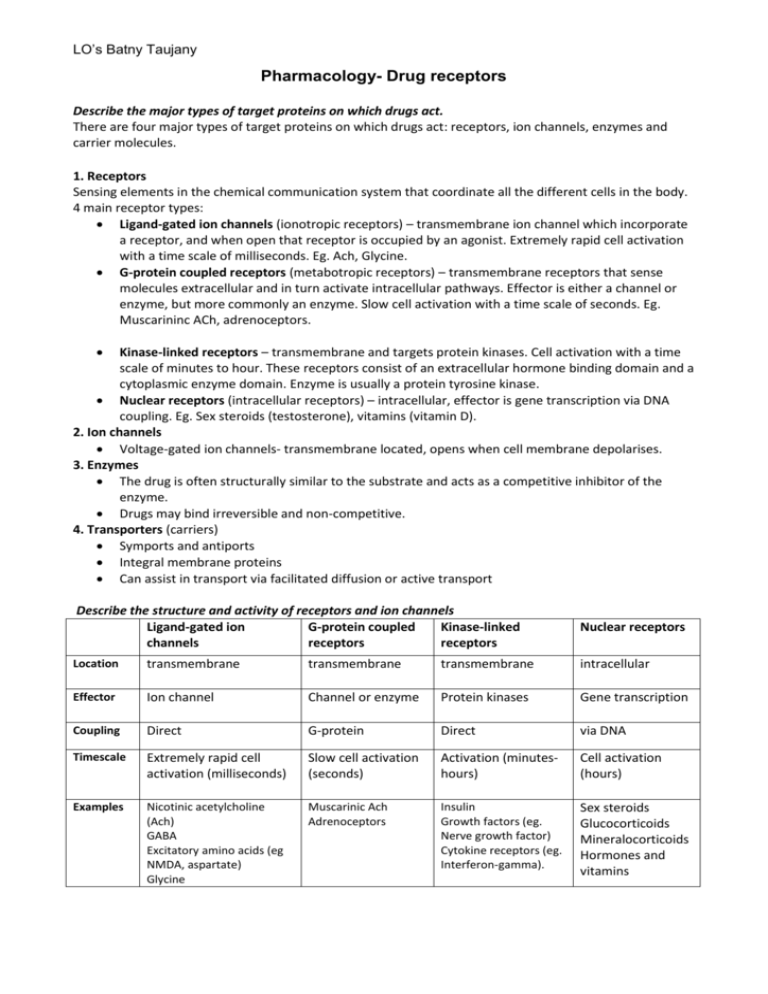
LO’s Batny Taujany Pharmacology- Drug receptors Describe the major types of target proteins on which drugs act. There are four major types of target proteins on which drugs act: receptors, ion channels, enzymes and carrier molecules. 1. Receptors Sensing elements in the chemical communication system that coordinate all the different cells in the body. 4 main receptor types: Ligand-gated ion channels (ionotropic receptors) – transmembrane ion channel which incorporate a receptor, and when open that receptor is occupied by an agonist. Extremely rapid cell activation with a time scale of milliseconds. Eg. Ach, Glycine. G-protein coupled receptors (metabotropic receptors) – transmembrane receptors that sense molecules extracellular and in turn activate intracellular pathways. Effector is either a channel or enzyme, but more commonly an enzyme. Slow cell activation with a time scale of seconds. Eg. Muscarininc ACh, adrenoceptors. Kinase-linked receptors – transmembrane and targets protein kinases. Cell activation with a time scale of minutes to hour. These receptors consist of an extracellular hormone binding domain and a cytoplasmic enzyme domain. Enzyme is usually a protein tyrosine kinase. Nuclear receptors (intracellular receptors) – intracellular, effector is gene transcription via DNA coupling. Eg. Sex steroids (testosterone), vitamins (vitamin D). 2. Ion channels Voltage-gated ion channels- transmembrane located, opens when cell membrane depolarises. 3. Enzymes The drug is often structurally similar to the substrate and acts as a competitive inhibitor of the enzyme. Drugs may bind irreversible and non-competitive. 4. Transporters (carriers) Symports and antiports Integral membrane proteins Can assist in transport via facilitated diffusion or active transport Describe the structure and activity of receptors and ion channels Ligand-gated ion G-protein coupled Kinase-linked channels receptors receptors Nuclear receptors Location transmembrane transmembrane transmembrane intracellular Effector Ion channel Channel or enzyme Protein kinases Gene transcription Coupling Direct G-protein Direct via DNA Timescale Extremely rapid cell activation (milliseconds) Slow cell activation (seconds) Activation (minuteshours) Cell activation (hours) Examples Nicotinic acetylcholine (Ach) GABA Excitatory amino acids (eg NMDA, aspartate) Glycine Muscarinic Ach Adrenoceptors Insulin Growth factors (eg. Nerve growth factor) Cytokine receptors (eg. Interferon-gamma). Sex steroids Glucocorticoids Mineralocorticoids Hormones and vitamins LO’s Batny Taujany Describe the various forms of receptor-effector linkages. LIGAND-GATED ION CHANNELS - IONOTROPIC Nicotinic ACh Receptor 5 subunits (alpha, gamma, alpha, beta, delta) - form a pore in the membrane Activation requires 2 ACh molecules bind 2 alpha subunits –conformational change –channel opens. Allows passage of Na+, K+, Ca2+ G-PROTEIN COUPLED RECEPTORS – METABOTROPIC Many extracellular ligands act by increasing intracellular concentration of second messengers Principle 2nd messengers: cAMP, Ca2+, Phosphoinositides. Role of G-Proteins G-proteins recognise activated GPCRs and communicate to effector system 3 subunits – α β γ anchored to membrane Coupling of α-subunit to an agonist-occupied receptor causes bound GDP to be replaced by GTP α-GTP complex dissociates from receptor and the β γ complex α-GTP complex can then interact with a target protein (enzyme or ion channel) β γ complex may also activate a target protein GTP-ase activity of α-subunit increases when bound to a target – leading to hydrolysis of bound GTP back to GDP + P α then reunites with β γ complex Specificity is due to molecular variation of alpha subunit (> 20 subtypes) G proteins may be inhibitory or stimulatory Targets for G-Proteins Adenylate cyclase/cAMP system Phospholipase C/inositol phosphate system Regulation of ion channels KINASE-LINKED RECEPTORS Extracellular hormone binding domain and a cytoplasmic enzyme domain. Enzyme is usually protein tyrosine kinase (serine kinase or guanyl cyclase). Hormone Binding NUCLEAR RECEPTORS Agonist-receptor complex acting on DNA results in either: Transcription and translation of mediator proteins Repression of expression of certain genes with inhibition of production of specific proteins.
